The 2nd edition of the Supply Chain Leadership Forum, themed “Futurecasting Supply Chain – The Paradigm Shift of Planet and People,” unfolded with a profound exploration of the global, regional, and local dynamics influencing the supply chain landscape. Panel Session 1, titled “The Big Picture,” provided a comprehensive overview and insightful prescriptions for success in the ever-evolving supply chain industry.
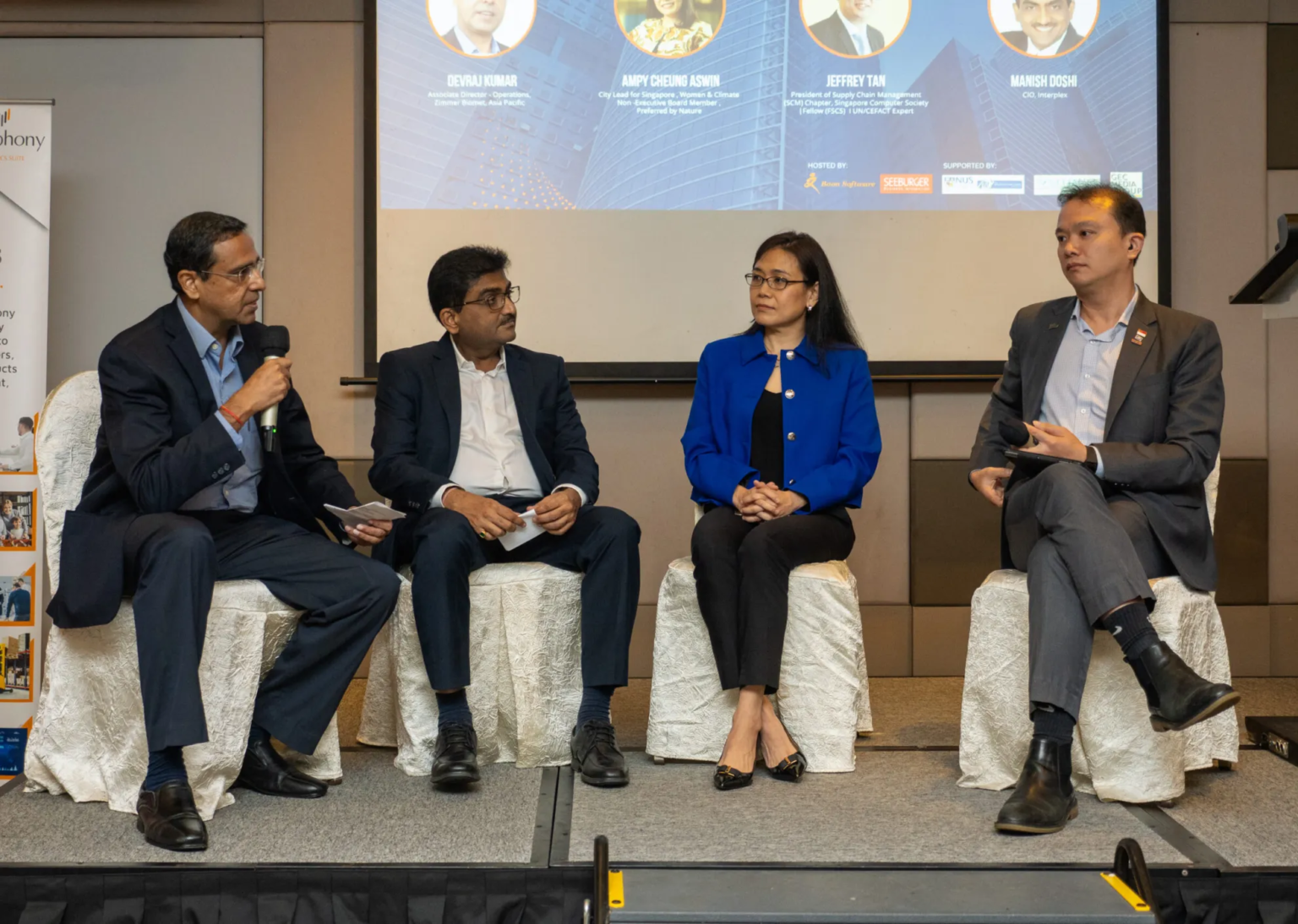
In the Supply Chain Leadership Forum’s session on “The Big Picture,” Ampy Cheung Aswin, City Lead for Singapore, Women & Climate, Non-Executive Board Member, Preferred by Nature, provided valuable insights into the resilience of the consumer goods sector amid contemporary challenges. Despite the industry’s exposure to global shifts such as China plus, nearshoring, and offshoring, the consumer goods sector’s movements remain relatively restrained, largely influenced by the intrinsic characteristics of its products.
Ampy emphasized the unique challenges faced by the consumer goods sector, shedding light on the pivotal role of product value density. The session highlighted that these products naturally gravitate towards demand centers, resulting in a prevalence of local and regional sourcing practices. Consequently, the sector experiences a distinctive operational landscape, characterized by less fluidity in changing sourcing strategies.
The nuanced perspective provided by Ampy underscores the importance of understanding the industry’s dynamics in response to global shifts. The emphasis on value density and the natural alignment of product movement with demand centers offers industry professionals a pragmatic lens through which to navigate the specific challenges faced by the consumer goods sector. This insight contributes to a comprehensive understanding of the industry’s resilience and operational patterns, fostering informed decision-making within the dynamic landscape of global supply chains.
“Because of the value density of the product, it naturally goes to where the demand center is. There’s a lot of local and regional sourcing. So it’s less of changing sourcing,”
– Ampy Cheung Aswin, City Lead for Singapore , Women & Climate, Non -Executive Board Member, Preferred by Nature (on the right)

Ampy Cheung Aswin sheds light on the pillars of supply chain success—agility and data. The session emphasized the critical role these elements play in navigating the nuanced landscape of the consumer goods sector. Ampy underscored that agility goes beyond a conceptual ideal; it involves the practical ability to respond to real-time market dynamics, a unique challenge faced by consumer goods businesses seeking to balance efficiency and resilience.
Ampy delved into the practical nuances of agility in the consumer goods sector. Her assertion that “Agility is about being able to respond to what’s happening real time” encapsulates the core challenge faced by industry professionals. This agility is contingent on seamless data connectivity, an element that acts as the lifeblood of supply chain responsiveness.
In unpacking the dynamics of the consumer goods sector, Ampy emphasized the paramount importance of data. Beyond its mere role as an informational tool, data becomes the linchpin for effective responses and connectivity in a sector where rapid, real-time adjustments are essential. The focus on these core principles provides a concrete guide for professionals grappling with the intricate dance of agility and data connectivity in the consumer goods supply chain.
As businesses seek to fortify their supply chains, the insights from this session offer a practical roadmap for industry leaders. The emphasis on agility and data connectivity serves as a call to action, prompting businesses to recalibrate their strategies to meet the unique demands of the consumer goods sector. In the pragmatic intersection of theory and practice, Ampy’s insights underscore the indispensable role of these cornerstones in achieving supply chain success.
“Agility is about being able to respond to what’s happening real time. And that has been a challenge in the consumer goods sector. This requires data, data being able to respond and connect to what’s happening,”
– Ampy Cheung Aswin, City Lead for Singapore , Women & Climate, Non -Executive Board Member, Preferred by Nature (on the right)
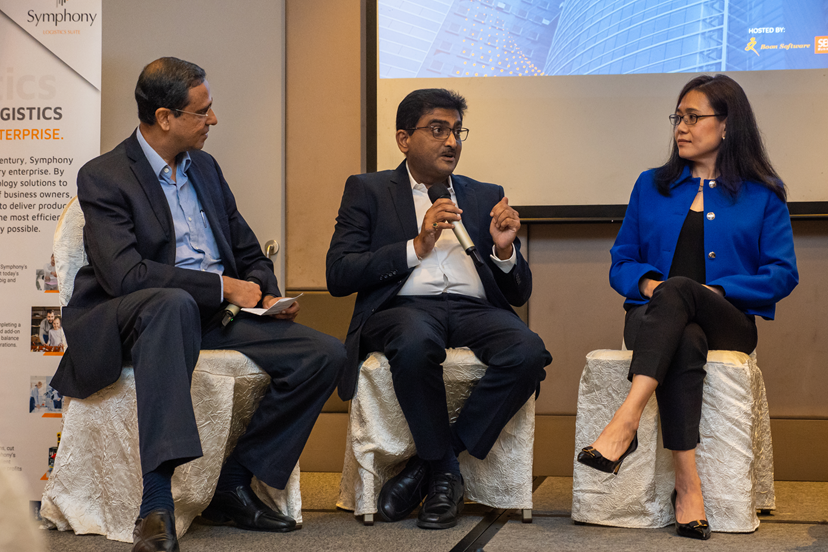
The session then delved into the collective responsibility borne by supply chains, with Ampy Cheung Aswin highlighting the significant environmental impact of the upstream supply chain. The nuanced discussion accentuated the broader industry responsibilities associated with sustainability, transcending the immediate concerns of efficiency and agility.
Ampy’s assertion that “supply chains are responsible for 80 percent of the emission” serves as a clarion call for a comprehensive examination of the environmental footprint left by these intricate networks. This statistical revelation places sustainability at the forefront of the supply chain narrative, emphasizing the substantial role that industry players need to play in mitigating their environmental impact.
The conversation, centered around the consumer goods sector, broadens the scope to encompass the entire supply chain ecosystem. The upstream supply chain emerges as a critical focal point, embodying the environmental repercussions of industry practices. Ampy’s pragmatic and factual approach directs attention to the imperative for supply chains to shoulder their responsibility in curbing emissions, aligning with global sustainability goals.
This perspective adds a layer of depth to the discourse on supply chain management. Beyond the conventional considerations of efficiency and agility, Ampy’s emphasis on sustainability positions it as a core pillar in the evolving landscape of responsible supply chain practices. As industry professionals navigate the intricacies of supply chain management, this reminder of collective responsibility offers a concrete framework for integrating sustainability into the core ethos of supply chain operations.
“When you’re looking at the consumer goods sector, it’s looking at the upstream supply chain…supply chains are responsible for 80 percent of the emission and therefore it has a responsibility to play,”
– Ampy Cheung Aswin, City Lead for Singapore , Women & Climate, Non -Executive Board Member, Preferred by Nature (2nd from the right)
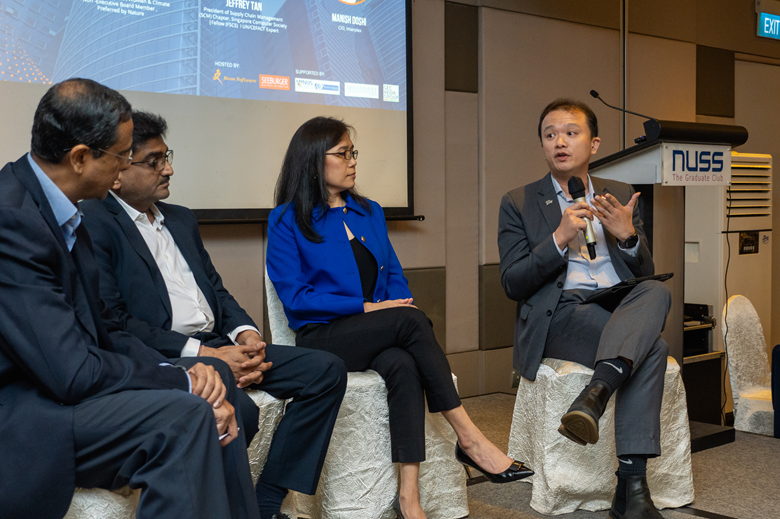
In an age characterized by swift technological progress and global economic transformations, the supply chain and logistics sector faces a spectrum of intricate challenges. The discussion offered valuable insights into these complexities, underscoring the critical importance of cultivating a strategic understanding of the broader industry landscape.
Jeffrey Tan, President of the Supply Chain Management (SCM) Chapter at the Singapore Computer Society and a distinguished UN/CEFACT Expert, emphasized the global nature of the industry. His statement, “This is a global business, an international business. You’re dealing with the movement of cargo from the U.S. to China to ASEAN. It’s not one country says it all,” succinctly captures the essence of the international dynamics influencing supply chains. The industry’s challenges, therefore, extend beyond national borders, requiring a nuanced approach to navigate the multifaceted terrain.
Jeffrey’s insights align with the overarching theme of the forum, emphasizing the necessity for a strategic grasp of the industry’s complexities. To tackle challenges effectively, professionals in the supply chain and logistics sector must move beyond localized perspectives. The evolving landscape demands a comprehensive understanding of the global interplay of factors influencing the movement of goods, making strategic foresight a cornerstone for resilience.
As professionals engage in the day-to-day intricacies of supply chain management, the forum’s message remains clear – success in this dynamic sector hinges on a global perspective. The evolving landscape necessitates an awareness of international intricacies, urging professionals to broaden their strategic lens for effective decision-making and sustainable supply chain practices.
“This is a global business, an international business. You’re dealing with the movement of cargo from the U.S. to China to ASEAN. It’s not one country says it all,”
– Jeffrey Tan, President of Supply Chain Management (SCM) Chapter, Singapore Computer Society, Fellow (FSCS) |UN/CEFACT Expert
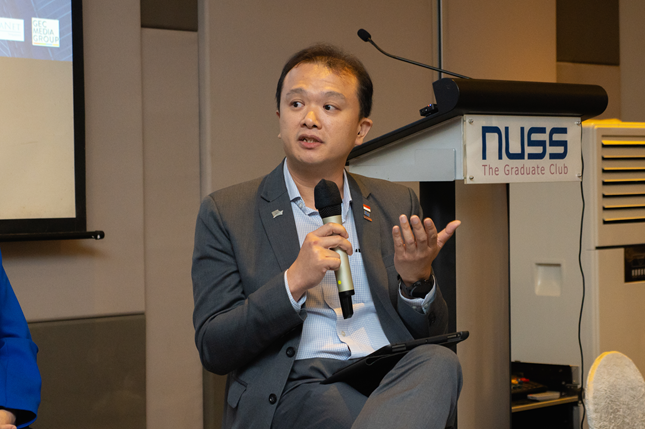
As the Supply Chain Leadership Forum unfolded, the significance of digitization emerged as a pivotal theme, reflecting the industry’s forward trajectory. However, the discourse took a cautionary turn as Ampy Cheung Aswin shed light on the intricacies and challenges entwined with this transformative process.
Ampy, injected a dose of pragmatism into the conversation. She cautioned against viewing digitization as a cure-all solution, noting that there exists a prevalent tendency to perceive it as the panacea for every industry challenge. As Ampy succinctly put it, “There is a tendency to think that digitization is the panacea for everything.”
Ampy’s insights delve into the often-overlooked aspects of digitization. She highlights the “soft elements” that tend to elude the spotlight during the digitization discourse. Her emphasis on the inability to digitize relationships and experiential knowledge underscores a crucial facet of the challenge. The cautionary note directs attention to the intangible and intricate aspects of the industry that resist seamless digitization.
In aligning with Ampy’s cautionary perspective, the overarching lesson here lies in the necessity for a nuanced understanding of digitization’s scope and limitations. The process goes beyond the mere application of technology, demanding a careful consideration of the human, relational, and experiential dimensions that shape the industry landscape. As the sector races towards digitization, acknowledging and addressing these subtleties becomes imperative for sustained success.
“There is a tendency to think that digitization is the panacea for everything… there are soft elements that people don’t see. You cannot just digitize relationships and experiential knowledge,”
– Ampy Cheung Aswin, City Lead for Singapore , Women & Climate, Non -Executive Board Member, Preferred by Nature (on the right)
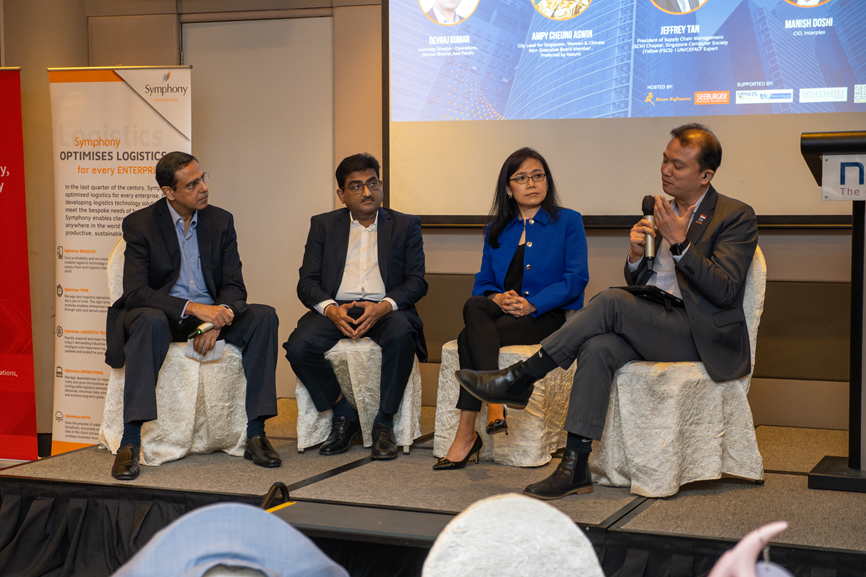
Manish Doshi, Chief Information Officer at Interplex, provided a succinct yet profound insight into the core challenge hindering digitization progress. Manish pinpointed a critical flaw in the typical approach, stating that “Digitization doesn’t work because we put technology without understanding the foundation of processes and data.” This succinct statement encapsulates a common pitfall – the oversight of foundational elements critical for the effective deployment of digitization initiatives.
Manish’s assertion prompts a closer examination of the foundational building blocks needed for successful digitization. The reference to processes and data implies a need for organizations to delve into the intricate details of their operational frameworks and informational structures. It’s not merely about adopting cutting-edge technology but ensuring that the very foundation on which it operates is solid and aligned with organizational objectives.
The lesson distilled from Manish’s perspective extends beyond rhetoric, emphasizing the necessity for organizations to invest in foundational elements before leaping into digital transformations. Whether it’s aligning charts of accounts, ensuring clean and structured data, or investing in super users with a strategic mindset, the crux lies in building a robust base. This strategic investment in foundational aspects forms the bedrock upon which successful digitization endeavors can flourish.
In a landscape where technology often takes center stage, Manish Doshi’s pragmatic perspective redirects the spotlight to the often underestimated yet crucial foundation. As organizations contemplate their digital journey, Doshi’s emphasis on understanding processes and data emerges as a practical guideline for steering clear of common pitfalls and ensuring a smoother transition into the digital era.
“Digitization doesn’t work because we put technology without understanding the foundation of processes and data,”
– Manish Doshi, CIO, Interplex (in the middle)
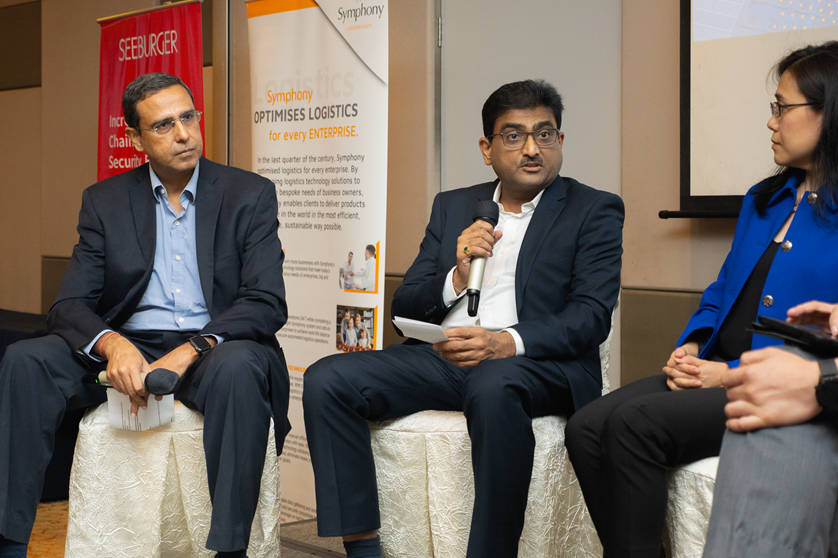
Jeffrey Tan provided insights into the leadership dynamics essential for industry-wide transformation. Jeffrey highlighted, “Leaders are the ones that should be educated. They should start from the top down and try to drive this agenda.” This concise statement encapsulates the essence of leadership’s pivotal role in steering the industry’s trajectory.
Jeffrey’s emphasis on education at the leadership level alludes to a crucial aspect of instigating change – knowledge. Leaders, often the torchbearers of organizational vision, need a comprehensive understanding of the realms of sustainability and digitalization. The call to start from the top signifies the importance of leadership setting the tone and direction for the entire organization.
The term “drive the agenda” implies a proactive and deliberate effort on the part of leaders to spearhead initiatives related to sustainability and digital transformation. This drive involves not just endorsement but active involvement in creating a vision, setting goals, and aligning the organization’s efforts with larger industry trends and expectations.
The discourse on leadership’s role in driving change serves as a clarion call for organizational leaders to step into the forefront of industry evolution. By acknowledging the need for education, commitment, and proactive agenda-setting, leaders can pave the way for a more sustainable and digitally transformed future in the realm of supply chain and logistics.
“Leaders are the ones that should be educated. They should start from the top down and try to drive this agenda,”
– Jeffrey Tan, President of Supply Chain Management (SCM) Chapter, Singapore Computer Society, Fellow (FSCS) |UN/CEFACT Expert
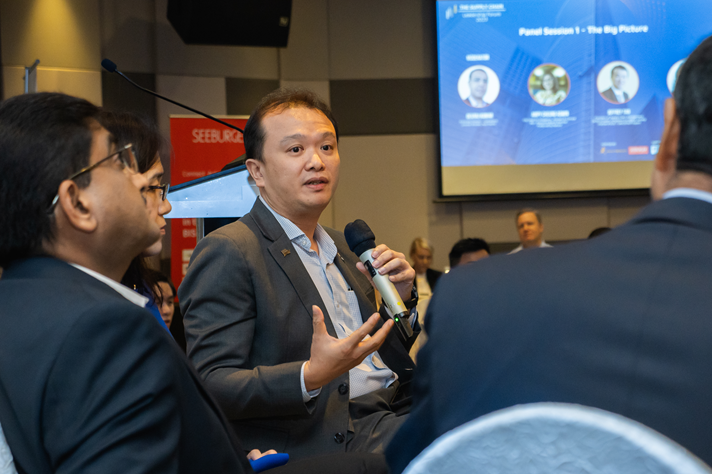
The forum brought forth a pragmatic discussion on the pivotal role played by economic incentives and commercial drivers in steering sustainability efforts within the industry. The speakers, encapsulating a collective industry wisdom, highlighted the nuanced relationship between financial considerations and the impetus for sustainable practices.
Ampy Cheung Aswin conveyed a fundamental truth –”People follow where the money flows.” This assertion underscores the pragmatic reality that financial implications and economic incentives are powerful catalysts for steering the ship towards sustainable practices.
Ampy’s reference to the impact of carbon tax serves as an illustrative example. The mention of impending financial consequences, in the form of a carbon tax, triggers a notable shift in behavior. The phrase “carbon tax is coming” implies a future event with financial ramifications, thereby prompting individuals and organizations to proactively seek knowledge and alter their practices in anticipation of the forthcoming economic changes.
The broader point conveyed is that sustainability efforts gain momentum when they are aligned with economic interests. The term “where the money flows” implies a pragmatic and business-centric approach to sustainability. It suggests that for widespread adoption, sustainability practices need to align with economic incentives, ensuring that the movement towards sustainability is not just an ethical choice but a financially sound decision.
The discussion on incentives and commercial drivers emphasizes the need for aligning sustainability efforts with economic interests. By recognizing the impact of financial implications and leveraging economic incentives, the industry can foster a more robust and sustainable future, where the pursuit of environmental goals seamlessly integrates with commercial objectives.
“People follow where the money flows. So when you say carbon tax is coming, people start to want to learn because it impacts,”
– Ampy Cheung Aswin, City Lead for Singapore , Women & Climate, Non -Executive Board Member, Preferred by Nature

Manish Doshi featured a notable case study that shed light on a company’s journey towards sustainability. The case study underscored the compelling factors driving this transition, prominently featuring customer demand and robust support from the board. The study served as a practical testament to the interplay between top-down commitment, customer expectations, and the strategic guidance required for a successful sustainability transformation.
In a succinct yet impactful statement, Manish conveyed a fundamental principle – “If it comes from the board and it’s a customer mandate, and you have somebody to help you go through the first two years, I think you’ll be in good shape.” This statement encapsulates the core elements crucial for a successful sustainability journey within an organization.
The phrase “comes from the board” implies that the impetus for sustainability initiatives should ideally originate from the highest echelons of organizational leadership. It emphasizes the pivotal role of top-down commitment, where the board sets the tone for sustainability goals. Additionally, the mention of a “customer mandate” signifies that external pressures, particularly from customers with a growing emphasis on sustainable practices, contribute significantly to an organization’s decision to embark on a sustainability journey.
The phrase “you have somebody to help you go through the first two years” underscores the significance of strategic guidance during the initial phases of sustainability implementation. This implies that having an experienced mentor or advisor can significantly contribute to overcoming challenges and ensuring a smoother transition. The reference to the “first two years” recognizes the early stages as critical, requiring careful navigation and expert assistance.
The case study presented aligns with established principles of organizational change, emphasizing the importance of top-down commitment and customer-driven initiatives in steering a company towards sustainability. It underscores that successful sustainability transformations are not only driven by internal vision but are also responsive to external market dynamics, particularly the expectations of customers. Furthermore, the acknowledgment of the need for guidance during the initial phases highlights the strategic planning required for a successful and enduring sustainability journey.
“If it comes from the board and it’s a customer mandate, and you have somebody to help you go through the first two years, I think you’ll be in good shape,” reflecting on the company’s sustainability journey.
– Manish Doshi, CIO, Interplex (on the middle)
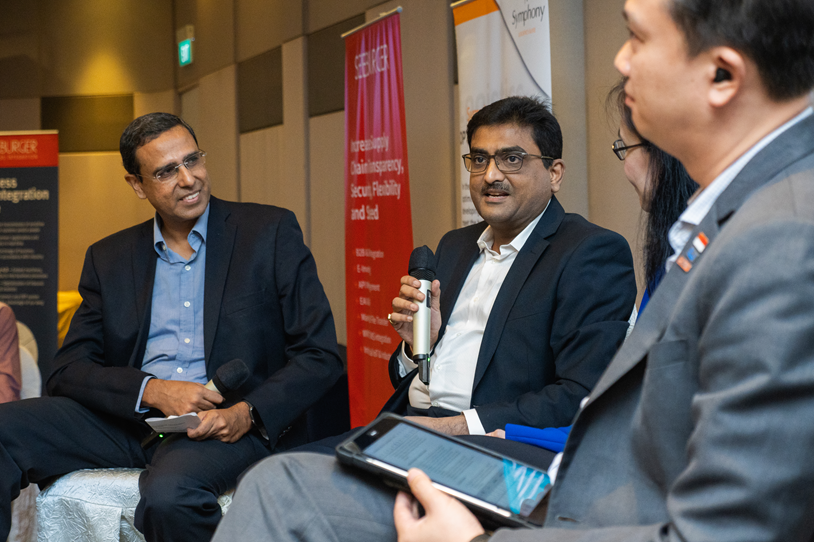
The 2nd edition of the Supply Chain Leadership Forum, through Panel Session 1, adeptly navigated the complexities of the current supply chain landscape. As the industry grapples with digital transformation, sustainability imperatives, and leadership challenges, the forum provided invaluable insights and prescriptions for success. The key takeaway: a strategic and holistic approach, guided by leadership commitment and a foundational understanding, is paramount in steering the supply chain industry towards a resilient and sustainable future.
Thank you for connecting with us. We are happy to hear from you. We’ll be in touch soon to schedule a time to understand your goals and present how the Symphony Logistics solutions optimises the business for every enterprise.